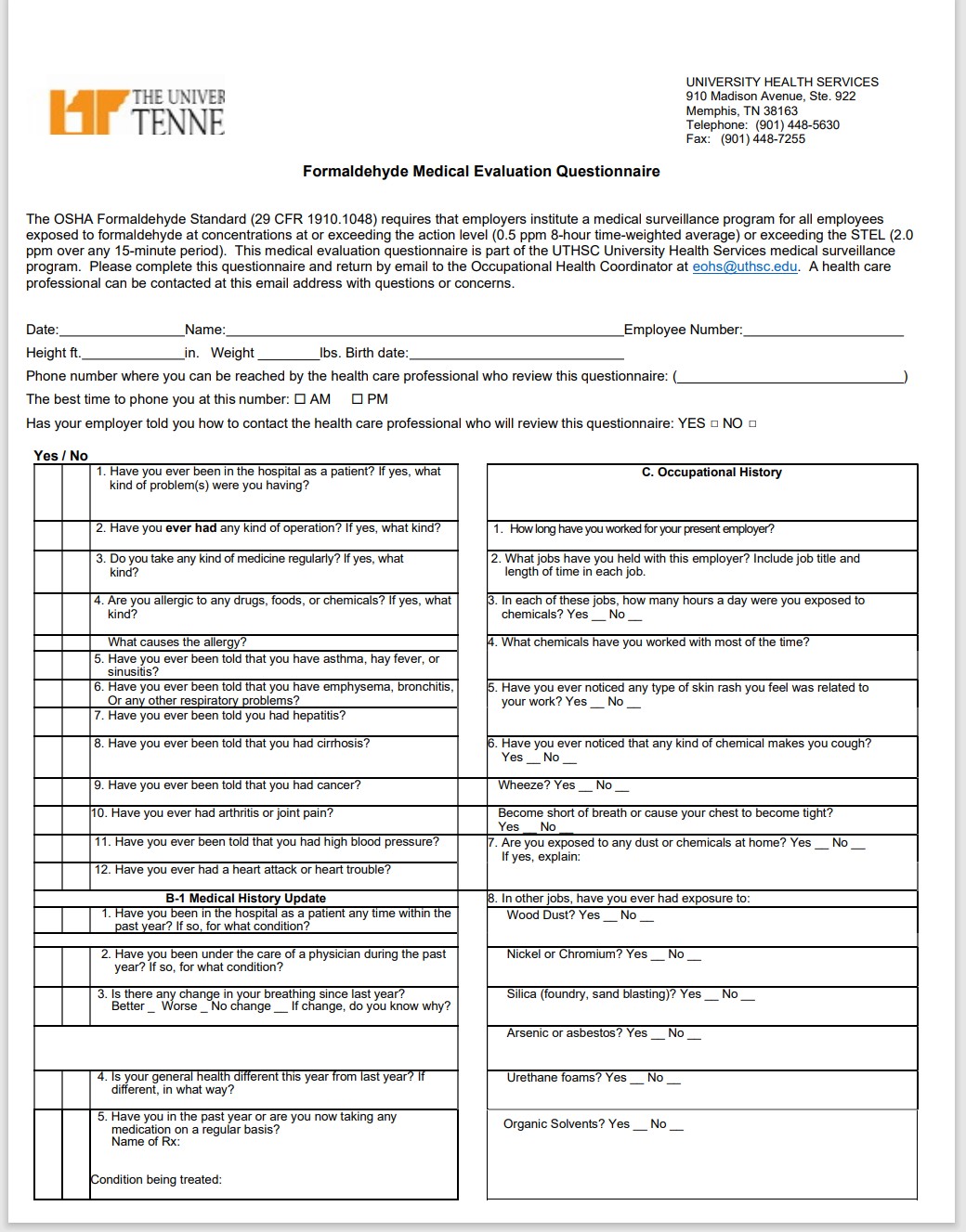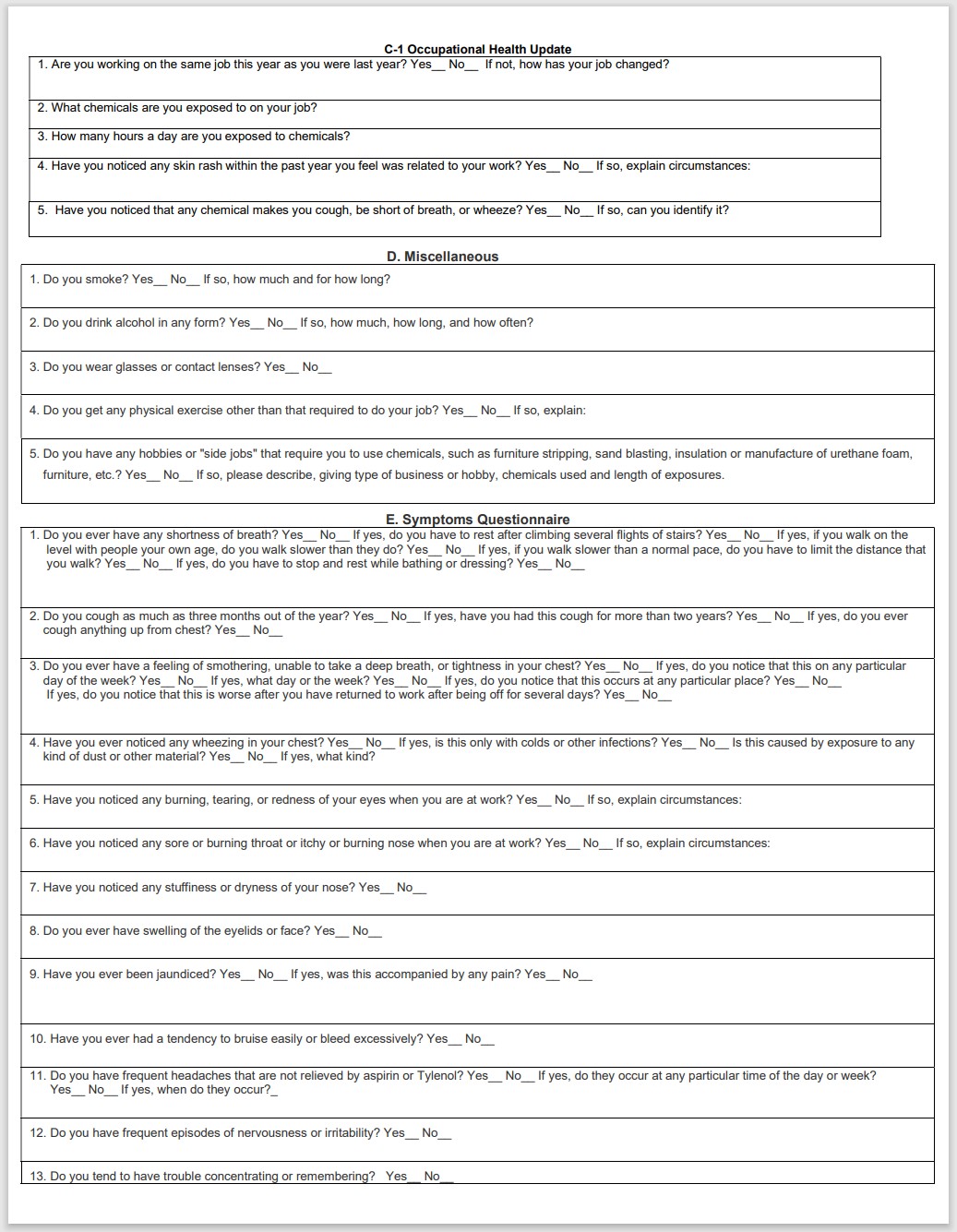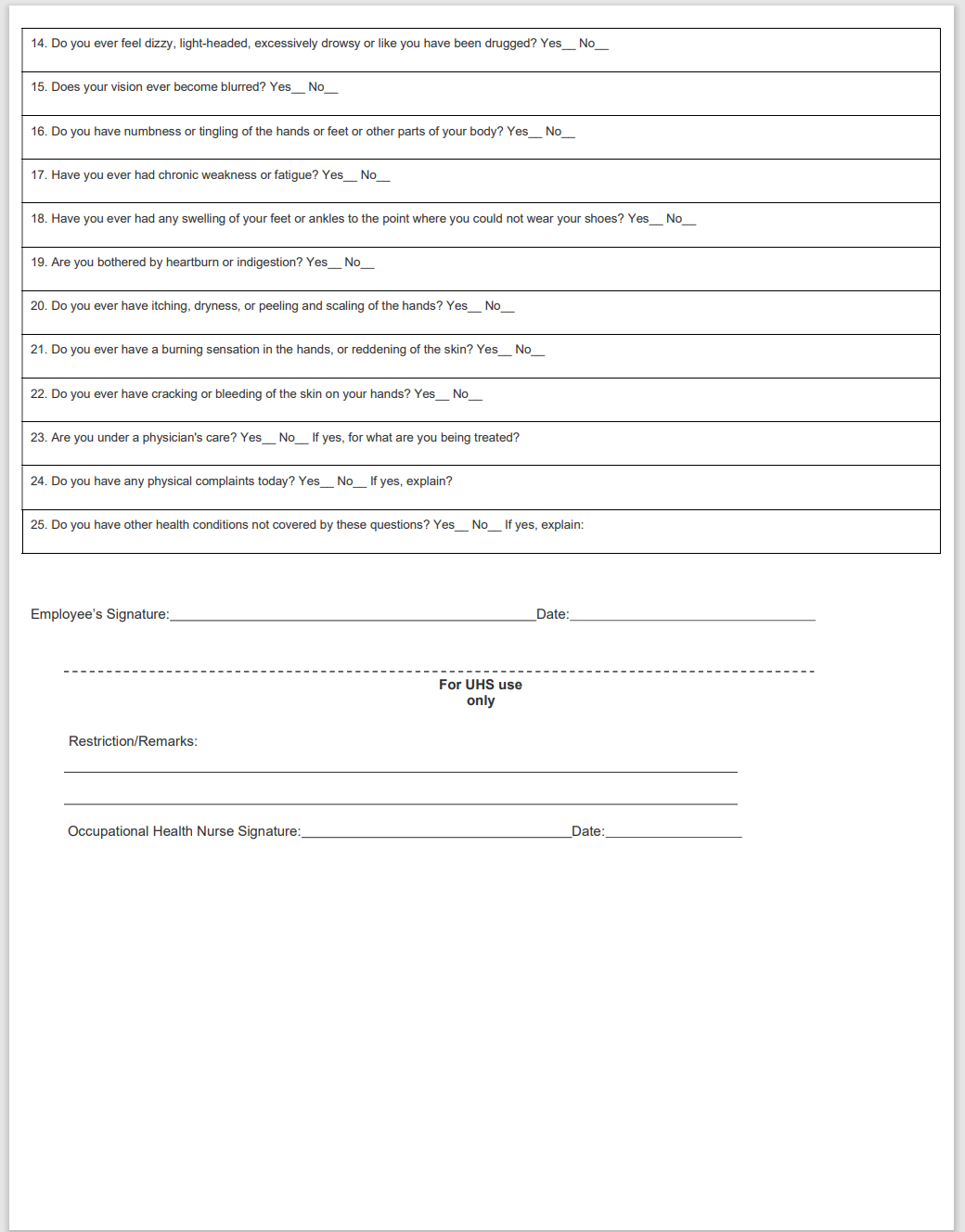Objective
To comply with the Tennessee Occupational Safety and Health Administration’s (TOSHA) Formaldehyde Standard and maintain formaldehyde exposures below the TOSHA occupational exposure limits.
Scope and Applicability
UTHSC employees who use or come in contact with formaldehyde and/or associated materials, such as paraformaldehyde and formalin, under normal working conditions or during emergencies.
Definitions
- Formaldehyde – The chemical substance, which has various hazards associated with it. For the purposes of this policy, formaldehyde includes all compounds of formaldehyde such as paraformaldehyde and formalin. The Chemical Abstracts Service (CAS) Registry No. is 50-00-0. This number can be used to find a Safety Data Sheet (SDS) for formaldehyde.
- Authorized personnel – Means any person required by work duties to be present in regulated areas and authorized to do so by the employer.
- Normal work conditions – Any activities that are completed during a typical work shift as listed in the employee’s job description.
- Emergency – Is any occurrence, such as but not limited to equipment failure, rupture of containers, or failure to control equipment that results in an uncontrolled release of a significant amount of formaldehyde.
- Gross Anatomy Lab– is the anatomy lab where students dissect cadavers that contain formaldehyde.
- Occupational Health and Safety Administration Formaldehyde Standard (OSHA Formaldehyde Standard) – A standard established by the Federal regulatory agency to control occupational exposures to formaldehyde through the use of action levels, permissible exposure limits, short term exposure limits addressing airborne concentrations. The reference number for this standard is 29 CFR 1910.1048.
- Action Level (AL) – Means a concentration of 0.5 parts formaldehyde per million parts of air (0.5 ppm) calculated as an eight (8)-hour time-weighted average (TWA) concentration, at which an assessment of exposure must begin.
- Permissible Exposure Limits (PEL) – The time-weighted-average concentration for a conventional 8-hour workday (0.75 ppm) and a 40-hour workweek below which nearly all employees may be repeatedly exposed, day after day, without adverse effect.
- Professor– is the instructor of the Gross Anatomy Lab
- Short Term Exposure Limits (STEL) – A 15-minute TWA exposure (2.0 ppm), which should not be exceeded at any time during a workday even if, the 8-hour exposure is within the OSHA-PEL as
Responsibilities
- College Dean/Department Chair/Department Director
- Ensure work area supervisors comply with the UTHSC procedure for formaldehyde.
- Work Area Supervisor/ Program Leader/Principal Investigator (PI)
- Identify processes that required personnel to handle formaldehyde or formaldehyde- related materials (e.g., formalin, PFA, etc.).
- Ensure personnel working with formaldehyde or any formaldehyde-related materials are familiar with the requirements of this procedure.
- Notify UTHSC Campus Safety department of processes or personnel that may be exposed to formaldehyde.
- Ensure personnel working with formaldehyde are aware of the hazards associated with formaldehyde. This may include a review of Safety Data Sheets (SDS) or similar hazard information.
- Ensure that personnel with the potential to be exposed above the Action Level complete formaldehyde hazard awareness training initially, when there is a change in production, equipment, process, personnel, or control measures which may result in a new or additional exposure to formaldehyde, and annually thereafter.
- Provide personnel with proper Personal Protective Equipment (PPE) and instructions in the use, maintenance, and limitations of this equipment.
- Ensure personnel properly use PPE when handling formaldehyde.
- Ensure personnel can locate and use chemical spill kits or contact the campus spill response team.
- Ensure personnel can report formaldehyde exposures and work area safety concerns.
- Ensure that employees whose responsibilities involve the potential for exposure above the AL or STEL, or who experience symptoms of formaldehyde exposure, participate in the University Health Services medical surveillance program.
- Employees in work areas where formaldehyde is handled:
- Understand the hazards associated with exposure to formaldehyde.
- Comply with work practices identified by the work area supervisor.
- Wear PPE as directed by the work area supervisor.
- Complete initial and annual formaldehyde training if working in areas where formaldehyde exposure may exceed the Action Level
- Participate in the medical surveillance program if working in areas where formaldehyde exposure may exceed the Action Level.
- Report exposures to the work area supervisor
- Report safety concerns to Campus Safety or their work area supervisor
- Campus Safety
- Maintain the campus Formaldehyde procedure.
- Perform formaldehyde exposure monitoring when necessary.
- Communicate personal exposure monitoring results to employees and supervisors.
- Provide formaldehyde training as required by the TOSHA Formaldehyde Standard.
- Provide respirator fit testing and training for personnel required to wear respirators.
- Maintain documentation as necessary to support this program (e.g., personal monitoring records, fit testing, etc.)
- University Health Services (UHS)
- Provide medical surveillance in accordance with OSHA Formaldehyde Standard requirements.
- Provide medical approval for respirator users capable of wearing a respirator.
- Maintain medical records pertaining to the formaldehyde medical surveillance program and approval for respirator users.
Procedure
- Supervisors must identify work areas where personnel handle formaldehyde or formaldehyde solutions, communicate the hazards of formaldehyde and safe work procedures to their employees and notify Campus Safety of the handling of formaldehyde solution.
- If formaldehyde exposure monitoring results identify the potential for personnel to be exposed at or above the PEL, and/or STEL, the work area supervisor shall work with Campus Safety and UTHSC Facilities to take appropriate corrective action, including:
- Assess the work practices of the affected employee.
- Develop a written plan describing corrective actions being taken to reduce exposure below the AL, PEL, and/or STEL.
- Provide a copy of the plan to affected employees.
- Ensure employee completes UHS formaldehyde medical evaluation questionnaire and submit to UHS for review.
- Implement additional engineering controls if available.
- If corrective measures do not maintain exposure below the PEL and/or STEL, after consultation with Campus Safety, the affected employee shall be supplied with appropriate respiratory protection in coordination with Campus Safety and enrolled into the Campus Respiratory Protection Program until the hazard can be mitigated by a more adequate control measure.
- Exposure Monitoring
- Personnel potentially exposed to formaldehyde shall be identified by various means (e.g., assessments and surveys), classified into exposure groups based on level of anticipated risk, and included in the sampling strategy for initial exposure monitoring.
- Campus Safety shall periodically measure and accurately determine exposure to formaldehyde for employees shown by the initial monitoring to be exposed at or above the action level or at or above the STEL.
- Monitoring shall be repeated each time there is a change in production, equipment, process, personnel, or control measures which may result in a new or additional exposure to formaldehyde. Note:
- It is prohibited to rotate employees for the purpose of limiting the exposure.
- Monitoring shall be terminated if results from two consecutive sampling periods taken at least 7 days apart show that employee or student exposure is below the AL, PEL, and the STEL unless periodic monitoring is specifically requested by the laboratory and Campus Safety.
- Notification of Monitoring Results
- Within 15 days of receiving monitoring results, Campus Safety shall provide written notification to the monitored employee, their supervisor, and University Health Services.
- Regulated Areas
- When repeated monitoring results shows the concentration of airborne formaldehyde is above the PEL and/or STEL, the Supervisor shall establish the area as a “regulated area” and post all entrances and accesses with observable signs containing these words:
DANGER FORMALDEHYDE
IRRITANT AND POTENTIAL CANCER HAZARD AUTHORIZED PERSONNEL ONLY - Access to regulated area shall be restricted to authorized personnel who have been trained to recognize the hazards of formaldehyde and to work safely using PPE.
- When repeated monitoring results shows the concentration of airborne formaldehyde is above the PEL and/or STEL, the Supervisor shall establish the area as a “regulated area” and post all entrances and accesses with observable signs containing these words:
- Respiratory Protection
- Respirator use shall only be permitted when engineering controls cannot be implemented, the current controls are not able to reduce exposure below the PEL/STEL, during the period of time before the installation of engineering controls, or during emergencies where exposure could exceed the PEL/STEL.
- Whenever respirator use is required, the employee shall be provided by their laboratory with an appropriate National Institute for Occupational Safety and Health (NIOSH) approved respirator at no cost, trained on proper use, and shall use it properly.
- Campus Safety will consult with the work area supervisor to select a respirator that reduces air-borne concentration of formaldehyde inhaled by the employee/student to at or below TWA or STEL.
- Campus Safety maintains a written respiratory protection program in accordance with the OSHA respiratory protection standard and provides training and fit testing for respirator users.
- Employees must obtain medical clearance from the University Health Services before fit testing and respirator use.
- Protective Equipment and Clothing
- Personal protective equipment (PPE) such as lab coats, gloves, goggles, face shields appropriate for use with formaldehyde, shall be provided at no cost to employees. The Supervisor shall ensure that employees:
- Use appropriate PPE when working with formaldehyde.
- Avoid contact of the eyes and skin with liquids containing one (1%) percent or greater formaldehyde by the use of chemical protective clothing made of material impervious to formaldehyde.
- Use non-latex gloves, such as nitrile or butyl when handling formaldehyde.
- Do not reuse PPE and/or clothing that has become contaminated with formaldehyde before it is cleaned or laundered.
- Do not take home PPE or clothing contaminated with formaldehyde.
- Are trained properly before handling or removing formaldehyde contaminated clothing.
- Are provided a room to change contaminated clothing, if needed.
- Have access to working eyewash and emergency showers and are trained to use them in case of emergency.
- Any person who launders, cleans, or repairs formaldehyde contaminated clothing or equipment shall be informed of formaldehyde’s potentially harmful effects and procedures to safely handle such material.
- Personal protective equipment (PPE) such as lab coats, gloves, goggles, face shields appropriate for use with formaldehyde, shall be provided at no cost to employees. The Supervisor shall ensure that employees:
- Housekeeping
- The workplace shall be maintained clean and free from formaldehyde contaminated debris.
- Formaldehyde contaminated debris and waste resulting from spills or other activities shall be placed for disposal in sealed container bearing label warning formaldehyde’s presence and its hazards.
- Employees involved in clean up or maintenance should be informed about the hazards associated with formaldehyde exposure during such activities
- Hazard Communication
- All provisions of this program shall be enforced in work areas where formaldehyde is used.
- Hazard warning labels that are in accordance with the Globally Harmonized System (GHS) and identify if the product contains formaldehyde shall be placed on the containers.
- Labels shall inform users of “Potential Cancer Hazard”.
- SDS shall be made accessible to employees
Emergency Contacts
- The work area supervisor shall be the primary contact and shall establish appropriate procedures and communicate to their employees and students respond to and properly report injuries or exposures.
- Employees exposed to formaldehyde causing a medical emergency shall seek immediate care and contact Corvel within 24 hours after the medical emergency has been treated and is no longer an emergency.
- Employees that experience non-emergency symptoms shall call Corvel within 24 hours and shall submit a formaldehyde medical evaluation questionnaire to University Health Services.
Medical Surveillance and Examinations
- UTHSC shall institute a medical surveillance program for employees exposed to formaldehyde at concentrations at or exceeding the action level or exceeding the STEL.
- UTHSC formaldehyde medical surveillance program is provided to affected employees only by University Health Services in a manner consistent with the OSHA Formaldehyde Standard.
Record Keeping
- Exposure Measurements
- Campus Safety maintains formaldehyde exposure monitoring records.
- Records shall include:
- Date of measurement.
- Operation being monitored.
- Method of sampling and analysis
- Number, duration, time, and results of samples taken.
- Type of protective device worn.
- Names, job title, UNI numbers and exposure estimates.
- Respirator Fit Testing
- The Campus Safety maintains records of training and fit testing for reusable respirators and N95 respirators
- The record shall include:
- Employee name, job title and employee/student ID number.
- A copy of the completed Respirator Medical Clearance Form.
- A copy of the completed Respirator Fit Test Record.
- The date of the most recent fit test
- Manufacturer, model, size & type of respirator provided to the employee
- Training
All training records will be maintained by Campus Safety.
- Medical
- All medical records will be maintained by UHS.
- Retention of Records
- The records shall be retained for at least the following periods:
- Exposure records and determinations shall be kept for at least 30 years.
- Medical records shall be kept for the duration of employment plus 30 years
- Respirator fit testing records shall be kept until they are replaced by a more recent record.
- The records shall be retained for at least the following periods:
References
- OSHA Standard 29 CFR 1910.1048. Occupational Exposure to Formaldehyde (http://www.osha.gov/pls/oshaweb/owadisp.show_document?p_table=STANDARDS&p_ id=10075)
- Policy for Personal Protective Equipment in Research Laboratories (https://research.columbia.edu/system/files/EHS/Policies/PPE.pdf)
Forms
- Medical Evaluation Questionnaire









